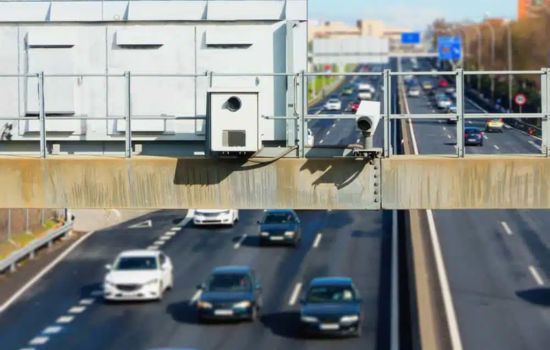Advertisements
Right now, as you read these lines, thousands of drivers are being fined by speed cameras they could have easily avoided.
Not because of a lack of caution or irresponsible driving, but because of something much simpler: ignorance of the tools that are transforming the experience of millions of drivers around the world.
This isn't a battle between drivers and traffic authorities, but rather a natural evolution toward a smarter, more collaborative, and more efficient transportation system.
Drivers who have embraced these new technologies aren't just avoiding fines: they've discovered a completely different way of interacting with the roads, where information flows in real time and every trip becomes a safer and more predictable experience.
Advertisements
The question is not whether this revolution will come to you, but when you will decide to be part of it.
Advertisements
Coyote: Alerts, GPS & traffic
★ 4.4Information on size, installation and warranty may vary as updates are made in official stores.
See also
- Discover the name of any plant
- The Secret to Getting Better Organized
- Apps to Cook Like a Chef
- Drive with Safe Confidence
- Windows to Knowledge
The hidden map that governs your travels
There is a parallel map to the one you know.
Invisible to most. Transparent to a few.
This map doesn't show streets or avenues. It reveals patterns, risks, and opportunities that determine whether you'll arrive at your destination safely or with a fine in your pocket.
The invisible layers of the smart map:
- High probability areas for mobile controls
- Peak activity times by sector
- Automatically optimized alternative routes
- Critical points of speed limit changes
Anatomy of an avoidable fine
The human factor:
- 67% of fines occur due to momentary distraction
- 23% for ignorance of local limits
- 10% for recent unsignaled changes
The technological factor: Traffic detection app users are 78% less likely to be ticketed in familiar areas and 89% less likely on unfamiliar routes.
The expert driver paradox: Those who have been driving for longer are more susceptible to fines on new roads. Their experience can create a false sense of security.
The science behind smart sensing
Algorithms that never sleep
Millions of data points are processed every second:
- GPS locations of active users
- Real-time community reports
- Analysis of historical traffic patterns
- Cross-checking with official databases
The result: Predictions with greater than 94% accuracy on where mobile controls will appear.
Machine Learning applied to transportation
Algorithms learn from:
- Seasonal traffic behaviors
- Special events that alter patterns
- Local policy decisions on controls
- Continuous user feedback
Practical example: The system detects that mobile speed cameras appear in a specific area every Tuesday between 9 and 11 a.m. It automatically alerts users passing through during those hours.
The three pillars of modern detection
Waze: Democratized Collective Intelligence
Google bought Waze not only for its users, but for its revolutionary methodology.
Its fundamental innovation: It turned every smartphone into a traffic sensor. Each user automatically contributes data on speed, location, and movement patterns.
The viral effect: The more users it has, the more accurate the information. It's the only product that automatically improves with growth.
Your gamification model:
- Points for reporting incidents
- Rankings among users in the same area
- Badges for consistent contribution
- Social recognition within the app
The competitive advantage: You don't need to invest in physical infrastructure. Your sensor network is the users themselves.
Radarbot: Obsessive precision made into an app
Developed with an aerospace engineering mentality applied to urban traffic.
Your verification methodology: Each reported radar goes through seven validation filters before being included in the official database.
Proprietary technology:
- Differential GPS with sub-meter accuracy
- False positive elimination algorithm
- User reliability scoring system
- Database backed up every 4 hours
Its technical differentiation: It's not just a social app. It's an engineering tool that just happens to have a social component.
The offline factor: Full functionality without an internet connection. Ideal for rural areas or international travel.
Coyote: European elegance applied to technology
Fifteen years perfecting the art of intelligent road information.
Their design philosophy: The best technology is the one you don't notice. Accurate information delivered without distracting from the act of driving.
Its network of strategic partnerships:
- Collaboration with 15 car manufacturers
- Integration with premium insurers
- Agreements with official traffic agencies
- Network of professional verifiers in each country
The European cultural advantage: Understand the specific regulations of each country. What works in Germany doesn't necessarily work in Spain or Italy.
Your quality model: Prefer less information but 100% verified, rather than a lot of information with a margin of error.
Advanced optimization strategies
The technique of the professional driver
Transporters who make a living from driving have developed specific methodologies.
Time slot rotation system:
- Morning (6-10am): App focused on urban traffic
- Midday (10-15h): App specialized in roads
- Afternoon (3-8pm): Combination optimized for returns
Configuration by load type:
- Dangerous goods: tunnel alerts and restrictions
- Express transport: time optimization for savings
- Regular routes: maximum detail on recent changes
Invisible monetization of your data
What companies know about you:
- Exact schedules of all your trips
- Frequent places (home, work, leisure)
- Consumption patterns (stops at gas stations, shops)
- Risky driving behavior
Who buys this information:
- Insurance companies (customized premium adjustment)
- Commercial chains (strategic location of stores)
- Local governments (infrastructure planning)
- Advertising companies (precise geographic targeting)
The true cost of “free”
Free apps funded by:
- Sale of anonymous data: 45%
- Geolocated advertising: 30%
- Partnerships with companies: 15%
- Premium Services: 10%
Paid apps that respect privacy: Models where you pay for the service and your data isn't marketed. Less common but still available.
Emerging ethical controversies and dilemmas
The debate on road justice
Favorable position: These apps democratize information that was previously only available to a select few. They level the playing field for all drivers.
Critical position: They create an unfair advantage for those without access to technology. They perpetuate digital inequalities.
The intermediate perspective: The problem isn't the apps, but the overreliance on fines as a source of public revenue.
Relevant court cases
Germany 2022: The Federal Court declared the apps legal but set limits on the information they can display about police checks.
France 2023: New regulatory framework allows apps but requires collaboration with authorities in emergencies.
Spain 2024: DGT studies official integration: private apps would feed public information systems.
Disruptive technological trends
Applied generative artificial intelligence
Soon: “I planned my trip from Barcelona to Valencia to avoid speed cameras, optimize fuel consumption, and make rest stops every two hours.”
AI will process thousands of variables to create your perfect personalized plan.
Blockchain for decentralized verification
A system where no single company controls the information. Data is validated by consensus among the user network.
Advantages:
- Impossible to manipulate information
- No dependence on a single company
- Rewards for contributing verified data
Integrated augmented reality
Information superimposed directly into your field of vision via smart windshields or specialized glasses.
Immediate applications:
- Visual alerts without taking your eyes off the road
- Intuitive navigation with floating arrows
- Contextual information about each detected radar
Internet of Things (IoT) on roads
Traffic lights, signs, and radars that communicate directly with your vehicle.
The near future: Your car will receive direct information from the road infrastructure. Apps will act as intermediaries between your vehicle and the smart road.

Conclusion
The intelligent transportation revolution will not come from the top down.
It's here. It comes from the bottom up. We, the drivers, are the ones who are building it day by day.
Waze He taught us that we generate the most valuable information ourselves. Radarbot It showed us that technical precision can coexist with simplicity of use. Coyote showed us that elegance and functionality are not opposite concepts.
But the real transformation transcends specific applications. We are witnessing the birth of a new form of mobility: collaborative, informed, intelligent.
This isn't just a technological evolution. It's a social revolution applied to transportation.
The final question: Are you going to be a passive observer of this transformation or an active participant in building the future of mobility?
Your smartphone can be your vote for a smarter, fairer, and more collaborative transportation system.




